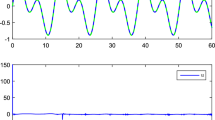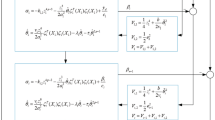Abstract
The modeling method is generally used to reconstruct the optical surface as a whole for the optical free- form surface with large gradient change. However, the reconstruction accuracy is limited that cannot meet the requirements, and the local characteristics of the surface cannot be accurately characterized. Therefore, a fast surface reconstruction method based on fractional- order T- S fuzzy predictive control is proposed by this paper. By constructing a hierarchical structure of a given data set and the method of layer- by- layer precision, the effect of global surface reconstruction is achieved, solving the problem caused by the use of local support radial basis functions. In addition, a strategy based on T- S fuzzy predictive control system is designed, and the asymptotic stability theorem of the T- S fuzzy predictive control system is proposed and proved. On this basis, the asymptotic stability of the fractional- order T- S fuzzy error system is proved, and the selection method of the gain matrix is given. The experimental results show that the proposed method is also suitable for the surface reconstruction of point cloud data with extremely uneven distribution or noise.






Similar content being viewed by others
References
Arunkumar N, Mohammed MA, Abd Ghani MK et al (2018) K-means clustering and neural network for object detecting and identifying abnormality of brain tumor. Soft Comput. https://doi.org/10.1007/s00500-018-3618-7
Arunkumar N, Mohammed MA, Mostafa SA, Ibrahim DA, Rodrigues JJPC, de Albuquerque VHC (2018) Fully automatic model-based segmentation and classification approach for MRI brain tumor using artificial neural networks. Concurrency Computat Pract Exper:e4962. https://doi.org/10.1002/cpe.4962
Burger PC, Yu IT, Tihan T et al (1998) Atypical teratoid/rhabdoid tumor of the central nervous system: a highly malignant tumor of infancy and childhood frequently mistaken for medulloblastoma: a pediatric oncology group study[J]. Am J Surg Pathol 22(9):1083
Dongdong J, Arunkumar N, Wenyu Z, Beibei L, Xinlei Z, Guangjian Z (2019) Semantic clustering fuzzy c means spectral model based comparative analysis of cardiac color ultrasound and electrocardiogram in patients with left ventricular heart failure and cardiomyopathy. Futur Gener Comput Syst 92:324–328
Elamaran V, Arunkumar N, Hussein AF, Solarte M, Ramirez-Gonzalez G (2018) Spectral fault recovery analysis revisited with Normal and abnormal heart sound signals. IEEE Access 6:62874–62879
Giorgio A, Ferraioli G, Tarantino L, de Stefano G, Scala V, Scarano F, Coppola C, Del Viscovo L (2004) Contrast-enhanced sonographic appearance of hepatocellular carcinoma in patients with cirrhosis: comparison with contrast-enhanced helical CT appearance.[J]. AJR Am J Roentgenol 183(5):1319–1326
Guo Y, Zhang Y, Klein R et al (2010) Irreversible electroporation therapy in the liver: longitudinal efficacy studies in a rat model of hepatocellular carcinoma[J]. Cancer Res 70(4):1555
Haoyu L, Jianxing L, Arunkumar N, Hussein AF, Jaber MM (2018) An IoMT cloud-based real time sleep apnea detection scheme by using the SpO2 estimation supported by heart rate variability. Futur Gener Comput Syst. https://doi.org/10.1016/j.future.2018.12.001
Jiajie L, Narasimhan K, Elamaran V, Arunkumar N, Solarte M, Ramirez-Gonzalez G (2018) Clinical decision support system for alcoholism detection using the analysis of EEG signals. IEEE Access 6:61457–61461
Kalligeros E, Kavousianos X, Bakalis D et al (2002) On-the-Fly reseeding: a new reseeding technique for test-per-clock BIST[J]. J Electron Test 18(3):315–332
Khamparia A, Singh A, Anand D et al (2018) A novel deep learning-based multi-model ensemble method for the prediction of neuromuscular disorders. Neural Comput & Applic. https://doi.org/10.1007/s00521-018-3896-0
Kim KH, Gwak MC, Yoh JJ (2015) An enhanced particle reseeding algorithm for the hybrid particle level set method in compressible flows[J]. J Sci Comput 65(1):431–453
Lakshmanaprabu S.K, Sachi Mohanty, Shankar K, Arunkumar N, Gustavo Ramirez, "Optimal deep learning model for classification of lung Cancer on CT images, Futur Gener Comput Syst, Vol. 92, 2019, Pg. 374–382
Lakshmi Nayak MD, Abrey LE, Iwamoto FM (2010) Intracranial dural metastases[J]. Cancer 115(9):1947–1953
Lee YT (1983) Leiomyosarcoma of the gastro-intestinal tract: general pattern of metastasis and recurrence[J]. Cancer Treat Rev 10(2):91–101
Lien WC, Lee KJ, Hsieh TY (2012) A Test-Per-Clock LFSR Reseeding Algorithm for Concurrent Reduction on Test Sequence Length and Test Data Volume[J]. Proceedings of the Asian Test Symposium, 278–283
Liu T, Kuang J, Cai S et al (2014) An effective logic BIST scheme based on LFSR-reseeding and TVAC[J]. Int J Electron 101(9):1217–1229
Ma X, Made ACZD, Autar B et al (2005) Targeted Biallelic inactivation of Pten in the mouse prostate leads to prostate Cancer accompanied by increased epithelial cell proliferation but not by reduced apoptosis[J]. Cancer Res 65(13):5730–5739
Oh SL, Hagiwara Y, Raghavendra U, Yuvaraj R, Arunkumar N, Murugappan M, Acharya UR (2018) A deep learning approach for Parkinson’s disease diagnosis from EEG signals. Neural Comput & Applic:1–7. https://doi.org/10.1007/s00521-018-3689-5
U. Rajendra Achary, Yuki Hagiwara, Sunny Nitin Deshpande, S. Suren, Joel En Wei Koh, Shu Lih Oh, N. Arunkumar, Edward J. Ciaccio, Choo Min Lim., "Characterization of focal EEG signals: a review"., Futur Gener Comput Syst, Vol. 91, Feb 2019, pg. 290–299
Santamaria-Granados L, Munoz-Organero M, Ramirez-Gonzalez G, Abdulhay E, Arunkumar N (2018) Using deep convolutional neural network for emotion detection on a physiological signals dataset (AMIGOS). IEEE Access. https://doi.org/10.1109/ACCESS.2018.2883213
Tan E, Qian W, Li Y (2009) An improved pattern generation for Built-in Self-test design based on boundary-scan reseeding[C]// International Conference on Communications
Wang Z, Yang J, Stern F (2009) An improved particle correction procedure for the particle level set method[J]. J Comput Phys 228(16):5819–5837
Wu Z, Wang H, Arunkumar N (2019) Bayesian analysis model for the use of anesthetic analgesic drugs in cancer patients based on geometry reconstruction. Futur Gener Comput Syst 93:170–175
Acknowledgements
The Scientific Research Program Funded by Shaanxi Provincial Education Department(Grant No.15JK1794).
Author information
Authors and Affiliations
Corresponding author
Additional information
Publisher’s note
Springer Nature remains neutral with regard to jurisdictional claims in published maps and institutional affiliations.
Rights and permissions
About this article
Cite this article
Yan-chun, G. Fractional- order T- S fuzzy predictive control based free- form Surface reconstruction. Multimed Tools Appl 79, 16955–16966 (2020). https://doi.org/10.1007/s11042-019-7534-3
Received:
Revised:
Accepted:
Published:
Issue Date:
DOI: https://doi.org/10.1007/s11042-019-7534-3




